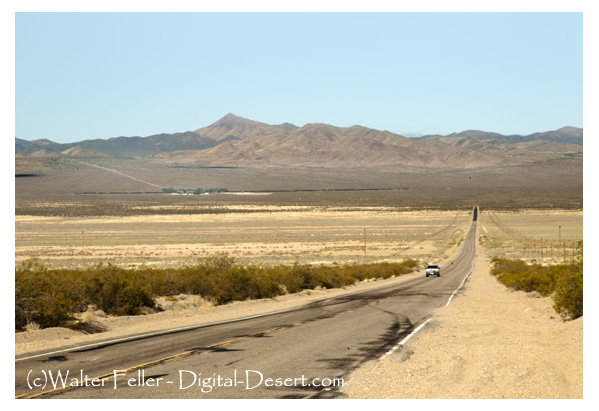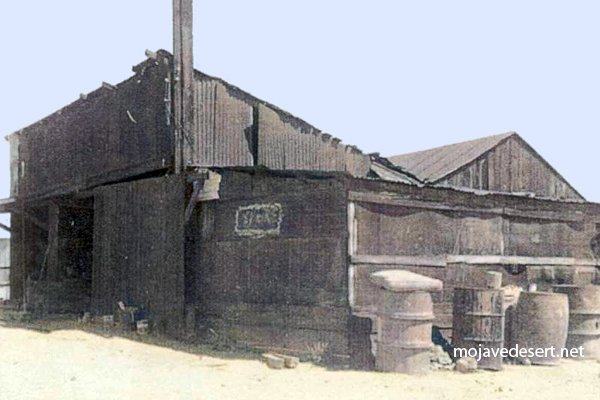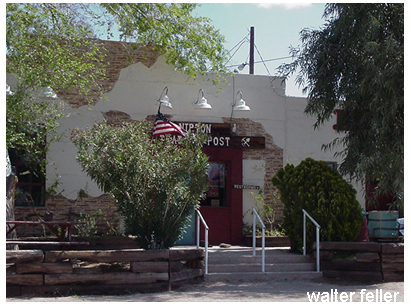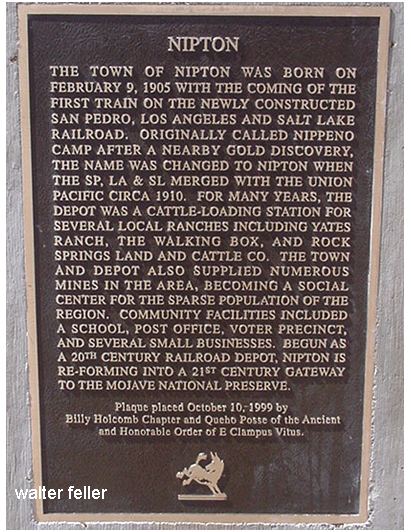Nipton, California

Originally called Nippeno Camp after a nearby gold discovery, the town
came to be in February, 1905 with the coming of the the first train on
the newly built
San Pedro, Los Angeles and Salt Lake Railroad.
The name was changed to Nipton when the SP, LA & SL merged with the
Union Pacific
about 1910. For many years the depot served mainly as a
cattle-loading station for several local ranches including the Yates Ranch,
Clara Bow's Walking Box, and
Rock Springs Land and Cattle Co. The town
also supplied numerous mines in the area, becoming a social center for the
sparsely populated region. Community facilities included a school,
post office, and several small businesses.

Nipeno Camp store
Dry land farmers homesteaded the high valleys of the east Mojave during the 1910s-40s. Homesteader Harry Treherne built this store in Nipton to serve homesteaders and ranchers. (BLM)
Gold and silver discoveries during the mid-1800s brought
hundreds of prospectors trekking across the eastern Mojave.
Ephemeral camps sprang up throughout the desert as
miners discovered copper and silver in nearby mountains.
Ranchers moving into high, grassy valleys, exploited the
market for beef created by the miners, and soon developed
commercial operations. The
Southern Pacific Railway
crossed the Mojave in 1883, giving ranchers access to larger
markets east and west, and their operations expanded.
Ranching and mining continue today. (BLM)
Nipton is a small unincorporated community located in the Mojave Desert in San Bernardino County, California, United States. It is situated on the northeastern edge of the Mojave National Preserve and is approximately 10 miles south of the Nevada state line.
Originally founded as a stop along the San Pedro, Los Angeles & Salt Lake Railroad in 1905, Nipton has a rich history dating back over a century. The town was named after the Nippeno Native American tribe that once inhabited the area. In its early years, Nipton was a crucial watering and rest stop for steam locomotives traveling between Los Angeles and Salt Lake City.
Today, Nipton is known for its unique charm and tranquil desert setting. The town is a popular destination for outdoor enthusiasts, offering various recreational activities such as hiking, camping, and birdwatching. Visitors can explore the stunning natural beauty of the Mojave Desert and enjoy breathtaking views of the surrounding mountains.
One of the main attractions in Nipton is the historic Nipton Hotel, built in 1905 and meticulously restored to its former glory. The hotel offers comfortable accommodations and a glimpse into the town's fascinating past. Guests can relax on the hotel's porch, enjoy the picturesque desert landscape, or explore nearby hiking trails.
In addition to its natural beauty, Nipton is also home to the Nipton Trading Post, a charming store where visitors can purchase unique souvenirs and local products. The trading post is a testament to the town's commitment to preserving its heritage and supporting local businesses.
Nipton is also known for being a solar-powered community, with the entire town powered by renewable energy sources. This commitment to sustainability and environmental consciousness sets Nipton apart from other communities in the area.
Overall, Nipton offers a unique and memorable experience for those seeking a peaceful retreat in the Mojave Desert. With its rich history, stunning natural beauty, and commitment to sustainability, it is a destination that captures the essence of California's diverse landscapes. Whether you are looking to explore the outdoors, relax in a historic hotel, or immerse yourself in the tranquility of the desert, Nipton is a place worth visiting.
Nipton Hotel
Searchlight
Walking Box Ranch
Mojave Preserve
Union Pacific
Nipton Timeline
Late 19th century: Two separate wagon trains crossed in the Ivanpah Valley. S.D. Karns arrived about the same time looking for gold. It is believed on Jan. 1, 1900, he and some associates staked a claim, which was named Nippeno.1905: A railroad connecting Salt Lake City to Los Angeles was completed in the winter of 1904/1905, which passed immediately by the crossroad and Nippeno Camp. Sen. William Clark of Nevda was instrumental in this.
1909: Karns died in Nipton.
1910: Several rail lines were merged into the Union Pacific Railroad System, and the name of the crossroads community was changed to Nipton. A stage coach line from Searchlight was established to carry passengers and freight to Nipton and the rail-head.
1930-1933: Nipton schoolhouse built.
1940: President Roosevelt signed papers transferring title of Nipton site to Harry Trehearne on April 10 under the Homestead Act. It stays in the family’s hands until 1956.
1956-1984: Nipton property passes into the stewardship of six owners.
1984: Freeman family (d.b.a. Provident Corp.) takes possession of the Nipton townsite. Escrow closed January 1985.
1986: Hotel Nipton, bed and breakfast inn opens for business in May. Nippeno House remodeling is completed in July to serve as primary residence for Freeman family.
1989: Nipton trading post starts selling California lottery tickets.
1994: Congress passes the Mojave National Preserve Act, which sets up Nipton as its defacto northern gateway.


